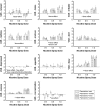Substance use, trait measures, and subjective response to nicotine in never-smokers stratified on parental smoking history and sex
- PMID: 19633275
- PMCID: PMC2725008
- DOI: 10.1093/ntr/ntp099
Substance use, trait measures, and subjective response to nicotine in never-smokers stratified on parental smoking history and sex
Abstract
Introduction: Male and female never-smokers stratified on parental history of smoking were tested for possible differences in susceptibility to the hedonic effects of nicotine.
Methods: We recruited nicotine-exposed never-smokers with two never-smoking biological parents (PH-) or two ever-smoking biological parents (PH+). After completing a baseline assessment battery focusing on conditions or behaviors associated with smoking, participants were tested for subjective and hedonic effects in response to administration of three different nicotine doses (0.0, 0.5, and 1.0 mg) via nasal spray. Physiological and biochemical reactivity also was monitored.
Results: PH+ were significantly more likely to report having experienced a "buzz" upon early smoking experimentation and to have histories of alcohol abuse and alcoholism; they also scored higher on disordered eating. In response to nicotine dosing, PH+ reported an increase in depressed mood, compared with a minimal response in PH-, in keeping with our expectation that nicotine would have more pronounced effects in PH+. Regardless of parental history, women reported experiencing greater anxiety in response to the highest nicotine dose, compared with men.
Discussion: Further exploration in larger samples, using more stringent selection criteria, a wider range of measures, and a less aversive dosing method, may provide a full test of the possible utility of the parental history model for illuminating biobehavioral mechanisms underlying response to nicotine. Also important would be broadening the scope of inquiry to include comparisons with ever-smokers to determine what protected PH+ from becoming smokers, despite the presence of factors that might be expected to decrease resilience and increase susceptibility.
Figures




Similar articles
-
Variability in initial nicotine sensitivity due to sex, history of other drug use, and parental smoking.Drug Alcohol Depend. 2009 Jan 1;99(1-3):47-57. doi: 10.1016/j.drugalcdep.2008.06.017. Epub 2008 Sep 4. Drug Alcohol Depend. 2009. PMID: 18775605 Free PMC article.
-
Escalating doses of transdermal nicotine in heavy smokers: effects on smoking behavior and craving.J Clin Psychopharmacol. 2013 Oct;33(5):667-74. doi: 10.1097/JCP.0b013e31829a829d. J Clin Psychopharmacol. 2013. PMID: 23963055
-
Dose-related enhancement of mood and cognition in smokers administered nicotine nasal spray.Neuropsychopharmacology. 2008 Feb;33(3):588-98. doi: 10.1038/sj.npp.1301425. Epub 2007 Apr 18. Neuropsychopharmacology. 2008. PMID: 17443125 Clinical Trial.
-
The subjective effects of nicotine: methodological issues, a review of experimental studies, and recommendations for future research.Nicotine Tob Res. 2002 Feb;4(1):25-70. doi: 10.1080/14622200110098437. Nicotine Tob Res. 2002. PMID: 11906682 Review.
-
Discriminative stimulus effects of nicotine in humans.Handb Exp Pharmacol. 2009;(192):369-400. doi: 10.1007/978-3-540-69248-5_13. Handb Exp Pharmacol. 2009. PMID: 19184656 Review.
Cited by
-
Subjective effects of transdermal nicotine among nonsmokers.Exp Clin Psychopharmacol. 2010 Apr;18(2):167-74. doi: 10.1037/a0018864. Exp Clin Psychopharmacol. 2010. PMID: 20384428 Free PMC article. Clinical Trial.
-
Never-smokers with a positive family smoking history are more likely to be overweight or obese than never-smokers with a negative family smoking history.Eat Behav. 2009 Jan;10(1):49-51. doi: 10.1016/j.eatbeh.2008.08.002. Epub 2008 Aug 27. Eat Behav. 2009. PMID: 19171318 Free PMC article.
-
Nicotine enhances alerting, but not executive, attention in smokers and nonsmokers.Nicotine Tob Res. 2013 Jan;15(1):277-81. doi: 10.1093/ntr/nts108. Epub 2012 May 9. Nicotine Tob Res. 2013. PMID: 22573728 Free PMC article.
-
CHRNB2 promoter region: association with subjective effects to nicotine and gene expression differences.Genes Brain Behav. 2011 Mar;10(2):176-85. doi: 10.1111/j.1601-183X.2010.00650.x. Epub 2010 Nov 4. Genes Brain Behav. 2011. PMID: 20854418 Free PMC article.
References
-
- American Psychiatric Association. Diagnostic and statistical manual of mental disorders. 4th ed. Washington, DC: American Psychiatric Association; 1994. (DSM-IV)
-
- Anzengruber D, Klump KL, Thornton L, Brandt H, Crawford S, Fichter MM, et al. Smoking in eating disorders. Eating Behaviors. 2006;7:291–299. - PubMed
-
- Barkley RA, Fischer M, Edelbrock CS, Smallish L. The adolescent outcome of hyperactive children diagnosed by research criteria: I. An 8-year prospective follow-up study. Journal of the American Academy of Child and Adolescent Psychiatry. 1990;29:546–557. - PubMed
-
- Benowitz NL, Lessov-Schlaggar CN, Swan GE, Jacob P., III Female sex and oral contraceptive use accelerate nicotine metabolism. Clinical and Pharmacological Therapeutics. 2006;79:480–488. - PubMed
-
- Bickel WK, Odum AL, Madden GJ. Impulsivity and cigarette smoking: Delay discounting in current, never, and ex-smokers. Psychopharmacology. 1999;146:447–454. - PubMed
Publication types
MeSH terms
Substances
Grants and funding
LinkOut - more resources
Full Text Sources
Medical

